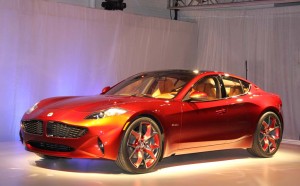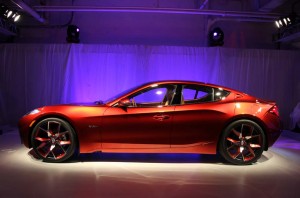Plagued by a cash shortage and struggling to find alternative funding sources in case it can’t free up a frozen government loan, California battery-car start-up Fisker Automotive is telling prospective investors it plans to delay by about a year the launch of its second product line.
The Fisker Atlantic is now expected to reach market sometime in mid-2014 according to leaked company documents that fell into the hands of the Inside EVs website. The struggling maker intends to move ahead with production at an old General Motors plant in Delaware despite sending signals that it might be looking for an alternative, lower-cost production site.
During a media preview prior to the New York Auto Show last month, Fisker declined to discuss specific details about the new extended-range electric vehicle. It would only hint that the new model would come in at “a much lower price point” than the current, $103,000 Fisker Karma.
But Fisker now is telling investors that it expects to price the Atlantic – until recently known by the codename Project Nina – somewhere in the $50,000 to $60,000 range. It will target the plug-in hybrid against the likes of the BMW 3- and 5-Series, Audi A4 and A5 and Mercedes-Benz C- and E-Class models.
Asked about the document, Fisker spokesman Roger Ormisher told TheDetroitBureau.com that, “We are not going to comment further on material that is clearly proprietary and confidential and has been leaked even though it was given under an NDA.”
But Ormisher added that, “I will say that Atlantic is very much part of Fisker’s future plans and once we have confirmed the necessary funding (either from the DoE or other sources) then we will be confirming a new timetable for the program.”
Fisker’s problems have been mounting in recent months. The maker got off to a late start with the Karma. That, in turn, led to the Department of Energy to put a hold on a $529 million federal loan that Fisker needed to complete development of the Atlantic and tool up the Delaware plant. The maker says it has raised a significant amount of money in the private equity market but confirms it still does not have enough to proceed to completion of the Atlantic project.
Complicating matters, Fisker discovered a manufacturing defect involving battery supplier A123 that forced a recall of earlier Karma models and led to an embarrassing recall. Then, earlier this month, authorities initially put the blame for a fire at a Texas home that destroyed several luxury vehicles on a Fisker Karma parked in the garage. The maker insists the vehicle was not at fault, however, noting its battery pack was intact. The investigation is ongoing.
The year-long delay in the Atlantic launch means a further cash crunch for Fisker.
But the firm insists it will bring things off with or without the government loan.
At first glance, the new Fisker Atlantic bears a striking similarity to the much more expensive Karma. But instead of the original model’s four-cylinder GM engine – which serves as a generator when the vehicle’s batteries run down – Atlantic will rely on a back-up engine from BMW. Fisker is telling investors that I-4 will make an even 300 horsepower. But it will also serve only as a generator and not directly power Atlantic’s wheels.
That should be enough to launch the Fisker Atlantic from 0 to 60 in about 6.5 seconds, a couple tenths slower than the current Karma. On an emissions front, Fisker is targeting a miniscule 50 grams of CO2 per mile, which should translate into an equivalent fuel economy approaching the 75 MPGe range, if not higher, according to estimates by TheDetroitBureau.com.
Despite the embarrassment of the recent Karma recall, Inside EVs notes that Fisker plans to retain A123 as the battery supplier on the Atlantic project.


